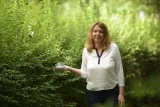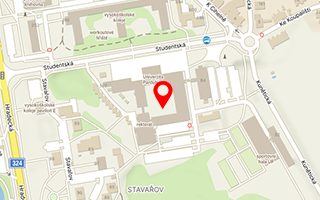Published: 24.11.2022
Beehives next to the dining halls. Solar panels on the roof. Cups instead of plastic bottles. Liběna Tetřevová, a researcher from the Faculty of Chemical Technology, has seen that such things can be reality at a university. Her project dealing with universities’ social responsibility draws on her inspiration from the BI Norwegian Business School.
What came as the biggest surprise at BI?
Porcelain cups and glasses placed next to bins. That was one of the first things that surprised me. BI uses them to replace plastics and disposable packaging, which they wish to get rid of by the end of the year. When using the kitchenettes or water dispensers, students may take a cup that will be left next to the bin to be re-used. That was my top finding. I am afraid, however, that such a solution would not be viable in the Czech Republic today since the cups would get destroyed and lost.
What does social responsibility mean for you?
For me, it is the responsibility of the management and employees, and students in the case of universities, with respect to the community and the environment. Social responsibility involves three areas. In the economic area, a company, a university, or a municipality should be socially responsible to the owners, investors, clients, suppliers, public authorities, and the public. For universities, this also involves the enhancement of relations with students, who are their clients, as well as with other universities. The social area involves the relationship with the employees and includes donations, sponsorships, or volunteer work.
And the third area?
The third area is the environment, which involves emission reductions, the use of renewable sources of energy, recycling or organising “green” conferences. The organisers of such conferences do their best to reduce their environmental impact, and thus recommend that the participants use sustainable means of transport, do not print any materials and the proceedings are only electronic. BI Norwegian Business School organises such conferences.
In Norway, you collected examples of best practices of social sustainability. What was the outcome?
The project involves an exchange of best practices of socially responsible activities. We try to map out best practices from the perspective of companies, universities, and municipalities. We are not interested only in the activities themselves, but also in how they are presented. For example, a socially responsible university may be more helpful if it shares information about its activities, and thus is an inspiration for others.
What are other areas of BI’s social responsibility?
What I particularly like about BI is that they first started applying the responsibility approach to themselves, and only then started teaching about it. The head of BI says that if they want their students to internalise the responsibility and sustainability approach, they must follow it themselves. BI monitors 17 UN sustainable development goals, with 3 goals being a focus, namely quality education, gender equality and climate action. They try to incorporate these goals into all areas of their activity.
What specific steps did BI introduce?
They try to integrate social responsibility and sustainable growth into all subjects. They also offer courses directly related to this topic, courses of ethics or sustainable development. For example, I found a course on sustainable business in Africa exciting; it involves a student trip to Tanzania where students visit businesses, a university, and NGOs. In these countries, social responsibility is in its infancy. But BI has students from all over the world. They aim to show the differences in social responsibility across countries, spark interest and initiate discussion about the need to develop sustainability in African countries. But you can see sustainability efforts even in school canteens. They take great care to select the food that is served. All their suppliers are eco-certified and offer local food, including vegetarian food.
What else did you notice in their campus?
I was surprised by the beehives on the canteen roof that are designed to enhance biodiversity. In terms of environmental responsibility, there are many examples that could serve as inspiration for Czech universities. The Oslo school campus uses geothermal energy for heating, and the energy consumption has been reduced by 30% since 2006. Other campuses use either solar panels or seawater. The school also intends to reduce emissions. Between 2017 and 2019, the emissions were cut by 21.6%. All campuses hold the Eco-Lighthouse certification, which is the most widely used Norwegian environment certification.
You have also mentioned that BI tries to make students and employees use environmentally friendly means of transport. How do they do that?
There are public transport stops as well as stations for shared bikes and scooters around the campus. If employees travel to work by car, they have to pay a small parking fee. Only owners of electric cars park for free. They also try to limit business trips to the minimum, so meetings were widely held online even before the pandemic. In addition, air travel quotas for employees were introduced, which compensates some 39% of emissions a year.
What is the situation at Czech universities compared to BI?
I believe there is a lot to learn. Some universities have their own beehives already, but in general, Czech universities’ socially responsible engagement is rather limited. Even if a university is active in the field, others do not know about it. We do not share best practices much. However, the pandemic has helped us to be more responsible. Testing capacities started being shared, and it was a stimulus for cooperation. We reduced our travel, meetings started being held online, not everything got printed and an electronic copy sent by e-mail sufficed. What is important is that universities guide students to be socially responsible. We are working with prospective employees and managers, and if they internalise the approach, they will be able to apply it in practice.
What could be the way forward in terms of social responsibility for the University of Pardubice?
We have started with our teaching activities, since some courses incorporate the ideas of social responsibility. The Faculty of Chemical Technology offers a programme called Sustainable Development in Chemistry and Technology. I see it feasible that such programmes focusing on social responsibility and sustainable development are offered by other faculties. Research-wise, first steps have been taken that need to be further developed. To give a specific example applicable to the University of Pardubice as a whole, a good start would be a more systematic approach to waste separation.
Is it possible to make the university campus more environmentally friendly and sustainable?
The campus consists of many buildings which lend themselves to the installation of solar panels. Given the rising energy prices, the use of renewables would be not only ecological, but also more economical. We could also try having more plants and flowerbeds in the campus, which is rather easy. Or re-using furniture. The departments and faculties scrap furniture that could be used elsewhere. Just taking a photo of such furniture and marketing it online would prolong its life. It would be discarded only when no one is interested.
Can students also contribute to social responsibility?
There are many things they can do, starting with how they make their way to school. Personally, as an eco-minded individual and researcher dealing with social responsibility, I would love to see a small parking fee for on-campus parking being considered. Students would not like it, probably, but it could make them refrain from going to school by car; or alternatively, car-sharing, which is also environment-friendly, could be used more often. It is often the case that a single student uses a car. Students could also start saving paper by not printing everything. All students have a laptop or a tablet so they do not need a printed version in most of the cases. But there are many more options.
So, is it enough to make little changes in our daily lives?
Indeed, for example, I can apply social responsibility to my shopping decision-making, but I can also take part in improvements of our campus, volunteer work or donations. There is a wide range of activities. They may find inspiration in the courses of social responsibility and sustainable production and consumption offered by our university.


